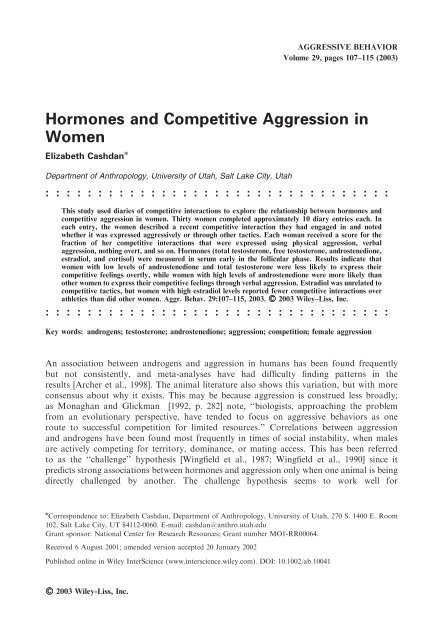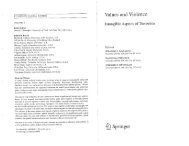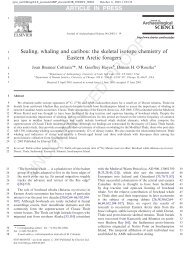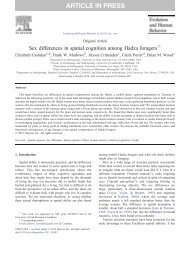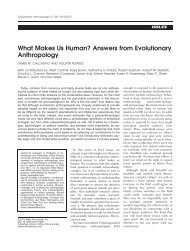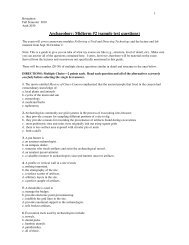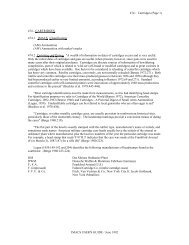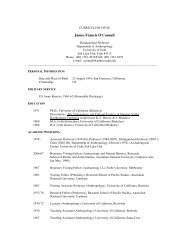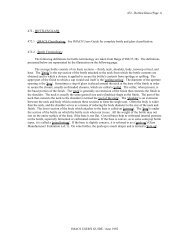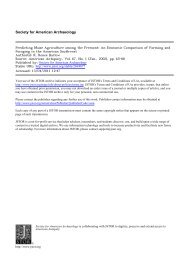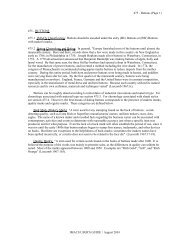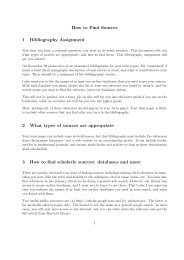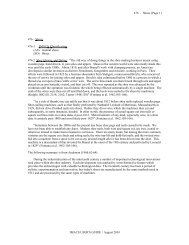Hormones and Competitive Aggression in Women - University of Utah
Hormones and Competitive Aggression in Women - University of Utah
Hormones and Competitive Aggression in Women - University of Utah
Create successful ePaper yourself
Turn your PDF publications into a flip-book with our unique Google optimized e-Paper software.
AGGRESSIVE BEHAVIOR<br />
Volume 29, pages 107–115 (2003)<br />
<strong>Hormones</strong> <strong>and</strong> <strong>Competitive</strong> <strong>Aggression</strong> <strong>in</strong><br />
<strong>Women</strong><br />
Elizabeth Cashdan n<br />
Department <strong>of</strong> Anthropology, <strong>University</strong> <strong>of</strong> <strong>Utah</strong>, Salt Lake City, <strong>Utah</strong><br />
: : : : : : : : : : : : : : : : : : : : : : : : : : : : : : : : :<br />
This study used diaries <strong>of</strong> competitive <strong>in</strong>teractions to explore the relationship between hormones <strong>and</strong><br />
competitive aggression <strong>in</strong> women. Thirty women completed approximately 10 diary entries each. In<br />
each entry, the women described a recent competitive <strong>in</strong>teraction they had engaged <strong>in</strong> <strong>and</strong> noted<br />
whether it was expressed aggressively or through other tactics. Each woman received a score for the<br />
fraction <strong>of</strong> her competitive <strong>in</strong>teractions that were expressed us<strong>in</strong>g physical aggression, verbal<br />
aggression, noth<strong>in</strong>g overt, <strong>and</strong> so on. <strong>Hormones</strong> (total testosterone, free testosterone, <strong>and</strong>rostenedione,<br />
estradiol, <strong>and</strong> cortisol) were measured <strong>in</strong> serum early <strong>in</strong> the follicular phase. Results <strong>in</strong>dicate that<br />
women with low levels <strong>of</strong> <strong>and</strong>rostenedione <strong>and</strong> total testosterone were less likely to express their<br />
competitive feel<strong>in</strong>gs overtly, while women with high levels <strong>of</strong> <strong>and</strong>rostenedione were more likely than<br />
other women to express their competitive feel<strong>in</strong>gs through verbal aggression. Estradiol was unrelated to<br />
competitive tactics, but women with high estradiol levels reported fewer competitive <strong>in</strong>teractions over<br />
athletics than did other women. Aggr. Behav. 29:107–115, 2003. r 2003 Wiley–Liss, Inc.<br />
: : : : : : : : : : : : : : : : : : : : : : : : : : : : : : : : :<br />
Key words: <strong>and</strong>rogens; testosterone; <strong>and</strong>rostenedione; aggression; competition; female aggression<br />
An association between <strong>and</strong>rogens <strong>and</strong> aggression <strong>in</strong> humans has been found frequently<br />
but not consistently, <strong>and</strong> meta-analyses have had difficulty f<strong>in</strong>d<strong>in</strong>g patterns <strong>in</strong> the<br />
results [Archer et al., 1998]. The animal literature also shows this variation, but with more<br />
consensus about why it exists. This may be because aggression is construed less broadly;<br />
as Monaghan <strong>and</strong> Glickman [1992, p. 282] note, ‘‘biologists, approach<strong>in</strong>g the problem<br />
from an evolutionary perspective, have tended to focus on aggressive behaviors as one<br />
route to successful competition for limited resources.’’ Correlations between aggression<br />
<strong>and</strong> <strong>and</strong>rogens have been found most frequently <strong>in</strong> times <strong>of</strong> social <strong>in</strong>stability, when males<br />
are actively compet<strong>in</strong>g for territory, dom<strong>in</strong>ance, or mat<strong>in</strong>g access. This has been referred<br />
to as the ‘‘challenge’’ hypothesis [W<strong>in</strong>gfield et al., 1987; W<strong>in</strong>gfield et al., 1990] s<strong>in</strong>ce it<br />
predicts strong associations between hormones <strong>and</strong> aggression only when one animal is be<strong>in</strong>g<br />
directly challenged by another. The challenge hypothesis seems to work well for<br />
n Correspondence to: Elizabeth Cashdan, Department <strong>of</strong> Anthropology, <strong>University</strong> <strong>of</strong> <strong>Utah</strong>, 270 S. 1400 E. Room<br />
102, Salt Lake City, UT 84112-0060. E-mail: cashdan@anthro.utah.edu<br />
Grant sponsor: National Center for Research Resources; Grant number MO1-RR00064.<br />
Received 6 August 2001; amended version accepted 20 January 2002<br />
Published onl<strong>in</strong>e <strong>in</strong> Wiley InterScience (www.<strong>in</strong>terscience.wiley.com). DOI: 10.1002/ab.10041<br />
r 2003 Wiley-Liss, Inc.
108 Cashdan<br />
birds [W<strong>in</strong>gfield et al., 1987, 1990] <strong>and</strong> at least some primates [Cavigelli <strong>and</strong> Pereira, 2000;<br />
Sapolsky, 1987].<br />
In the human literature, aggression is usually considered the <strong>in</strong>tentional harm<strong>in</strong>g <strong>of</strong> one<br />
person by another [Monaghan <strong>and</strong> Glickman, 1992], a very broad def<strong>in</strong>ition that <strong>in</strong>cludes<br />
both competitive <strong>and</strong> non-competitive situations. If the arguments <strong>in</strong> the preced<strong>in</strong>g<br />
paragraph apply to humans, we might expect stronger correlations when <strong>in</strong>dividuals are<br />
actively compet<strong>in</strong>g for resources or position. This expectation is consistent with the f<strong>in</strong>d<strong>in</strong>g<br />
that testosterone (T) is most strongly associated with aggression <strong>in</strong> adolescent boys when the<br />
aggression is a response to a provocative challenge [Olweus et al., 1988; but see Christiansen<br />
<strong>and</strong> Knusmann, 1987]. Such challenges would, <strong>in</strong> the real world, <strong>of</strong>ten be generated by<br />
competition for a resource or position <strong>of</strong> power. This paper, therefore, focuses explicitly on<br />
competitive aggression, s<strong>in</strong>ce it is anticipated that correlations with <strong>and</strong>rogens will be<br />
strongest <strong>in</strong> such situations.<br />
Although this type <strong>of</strong> aggression has been referred to as ‘‘<strong>in</strong>ter-male’’ [Moyer, 1968],<br />
females <strong>of</strong> many species, <strong>in</strong>clud<strong>in</strong>g humans, are also competitive. <strong>Women</strong> feel as competitive<br />
as men do if they are asked about th<strong>in</strong>gs that are salient to them [Cashdan, 1998], <strong>and</strong><br />
they <strong>of</strong>ten compete aggressively [Burbank, 1987; Campbell, 1991, 1995; Cook, 1992; Eagly<br />
<strong>and</strong> Steffen, 1986; Glazer, 1992; Schuster 1983]. Yet the relationship between hormones<br />
<strong>and</strong> aggression <strong>in</strong> females is even less clear than <strong>in</strong> males. Some studies <strong>of</strong> women <strong>and</strong><br />
girls have found positive correlations between circulat<strong>in</strong>g <strong>and</strong>rogen levels <strong>and</strong> aggression<br />
[Dabbs et al., 1988; Dabbs <strong>and</strong> Hargrove, 1997; Harris et al., 1996; In<strong>of</strong>f-Germa<strong>in</strong>e et al.,<br />
1988; Van Goozen et al., 1995; see also van Honk et al., 1999, 2001], but <strong>of</strong>ten for some<br />
aggression variables <strong>and</strong> not others, <strong>and</strong> sometimes for only one <strong>and</strong>rogen <strong>of</strong> several<br />
measured. Other studies have found no relationship between <strong>and</strong>rogen levels <strong>and</strong> aggression<br />
[Cohen-Kettenis <strong>and</strong> Gooren, 1992], <strong>and</strong> at least one study found a negative correlation<br />
[Gladue, 1991]. Nearly all <strong>of</strong> these studies have focused on testosterone, but <strong>and</strong>rostenedione<br />
is an important source <strong>of</strong> <strong>and</strong>rogen for women <strong>and</strong> may have a stronger role to play. This<br />
study measured levels <strong>of</strong> testosterone (free <strong>and</strong> total), <strong>and</strong>rostenedione, <strong>and</strong> estradiol <strong>in</strong><br />
women, <strong>in</strong> order to see whether any <strong>of</strong> them are associated with the use <strong>of</strong> aggression <strong>in</strong><br />
competitive <strong>in</strong>teractions.<br />
METHODS<br />
Study Population<br />
Thirty-four female <strong>University</strong> students enrolled <strong>in</strong> the study. The women were recruited<br />
through ads <strong>in</strong> the campus paper to stay <strong>in</strong> an on-campus residential facility, where students<br />
participate <strong>in</strong> research <strong>in</strong> exchange for reduced rent. They were told about the research,<br />
<strong>in</strong>clud<strong>in</strong>g the protocol for hormone collection, before agree<strong>in</strong>g to participate. All women<br />
<strong>in</strong>cluded <strong>in</strong> this study were between 19 <strong>and</strong> 26 years <strong>of</strong> age (mean 21.5 years), had regular<br />
menstrual cycles, <strong>and</strong> were not tak<strong>in</strong>g birth control pills or other hormonal medication.<br />
Participants were also non-smokers <strong>and</strong> were neither hirsute nor obese.<br />
Hormone Collection <strong>and</strong> Assay<br />
<strong>Hormones</strong> were assayed from serum. Each participant came to the lab one time early <strong>in</strong> her<br />
follicular phase (6–8 days after the beg<strong>in</strong>n<strong>in</strong>g <strong>of</strong> her menstrual period). Although <strong>and</strong>rogen
<strong>Hormones</strong> <strong>and</strong> <strong>Competitive</strong> <strong>Aggression</strong> <strong>in</strong> <strong>Women</strong> 109<br />
levels are higher at midcycle, samples were taken <strong>in</strong> the early follicular phase for two reasons:<br />
(1) to get better control over cycle phase, s<strong>in</strong>ce it is difficult to time ovulation without regular<br />
monitor<strong>in</strong>g <strong>of</strong> temperature or other <strong>in</strong>dicators, <strong>and</strong> (2) to more easily average over LH<br />
pulsations, which occur with higher frequency (about once an hour) <strong>in</strong> this phase <strong>of</strong> the cycle.<br />
In order to average over LH pulsations, three blood samples were taken at 15–m<strong>in</strong>ute<br />
<strong>in</strong>tervals <strong>and</strong> pooled for analysis. In order to control for diurnal variation <strong>in</strong> hormone levels,<br />
lab appo<strong>in</strong>tments were scheduled to take place approximately one hour after the participant’s<br />
usual ris<strong>in</strong>g time (tim<strong>in</strong>g <strong>of</strong> blood draws ranged from 7:15 am to 9:45 am).<br />
Blood draws <strong>and</strong> assays were done by the <strong>University</strong> <strong>of</strong> <strong>Utah</strong> Cl<strong>in</strong>ical Research Center.<br />
Serum levels <strong>of</strong> total testosterone (TT), free (unbound) testosterone (FT), estradiol (E) <strong>and</strong><br />
cortisol (C) were measured with Coat–A–Count Radioimmunassay kits from Diagnostic<br />
Products Corp. (Los Angeles, CA) <strong>and</strong> serum <strong>and</strong>rostenedione (A) levels were measured with<br />
a radioimmunoassay kit supplied by Diagnostics Systems Laboratories (Webster, TX). All<br />
assays were done accord<strong>in</strong>g to kit protocol, <strong>and</strong> controls fell with<strong>in</strong> accepted limits. Interassay<br />
<strong>and</strong> <strong>in</strong>tra-assay coefficients <strong>of</strong> variation were less than 10%.<br />
Competition Diaries<br />
Data on how competition was expressed (i.e., aggressively or non-aggressively) were<br />
derived from diaries, which acted as a form <strong>of</strong> guided recall. Participants were asked to th<strong>in</strong>k<br />
about the day’s events each even<strong>in</strong>g <strong>and</strong> complete an entry each time they had someth<strong>in</strong>g to<br />
report. They were asked to fill out a total <strong>of</strong> 10 forms each, which they did over the course <strong>of</strong><br />
an academic term.<br />
Participants were given the follow<strong>in</strong>g written <strong>in</strong>structions:<br />
Were there times today when you felt competitive with others, or when you sensed that<br />
they were compet<strong>in</strong>g with you If so, please use this form to describe one <strong>of</strong> those times.<br />
Please review the <strong>in</strong>struction page to see how to fill out the questionnaire.<br />
The <strong>in</strong>struction form def<strong>in</strong>ed competition very broadly, as follows:<br />
What do we mean by competition Typically, competition <strong>in</strong>volves try<strong>in</strong>g to improve one’s<br />
position relative to someone else’s, or try<strong>in</strong>g to have someth<strong>in</strong>g that someone else wants. The<br />
categories on the forms should clarify this further. For our purposes, competition is def<strong>in</strong>ed<br />
very broadly, <strong>and</strong> need not take place as a discrete event. If you are feel<strong>in</strong>g competitive about<br />
someth<strong>in</strong>g, it counts as competition.<br />
The diary form asked what the competition was about, who the competition was with, how<br />
the competition was expressed, how it was resolved, <strong>and</strong> how strongly the person felt about<br />
the particular <strong>in</strong>teraction. In order to make responses comparable, a series <strong>of</strong> options was<br />
listed, followed by a space for comments. The options were derived from earlier unstructured<br />
diaries <strong>and</strong> trial forms. The diary form listed eight options for the way competition was<br />
expressed:<br />
1. physical aggression<br />
2. verbal aggression (put-downs, barbed humor, sarcasm, be<strong>in</strong>g argumentative)<br />
3. verbal assertiveness (non-aggressive comparisons or discussion)<br />
4. show<strong>in</strong>g-<strong>of</strong>f<br />
5. do<strong>in</strong>g the activity faster or better<br />
6. tak<strong>in</strong>g possession <strong>of</strong> desired object or space<br />
7. noth<strong>in</strong>g overt happened; I just felt competitive without express<strong>in</strong>g it<br />
8. other
110 Cashdan<br />
Participants were asked to check as many tactics as they wished for each <strong>in</strong>teraction, <strong>and</strong> to<br />
<strong>in</strong>dicate which tactics were taken by themselves <strong>and</strong> which by their competitors. Only the<br />
former are considered here.<br />
Indirect aggression through social manipulation was not <strong>in</strong>cluded <strong>in</strong> the diary form,<br />
because it was not volunteered by participants <strong>in</strong> the open-ended diaries <strong>and</strong> pretests that led<br />
to its development. This is unfortunate but not surpris<strong>in</strong>g; as Bjo¨rkqvist et al. [1992] note,<br />
such manipulation is socially undesirable <strong>and</strong> hence is unlikely to be admitted or<br />
acknowledged through self-report.<br />
Twelve options were listed for what the competitive <strong>in</strong>teraction was about, <strong>and</strong><br />
participants were told to <strong>in</strong>dicate which option was most appropriate:<br />
1. success at school (gett<strong>in</strong>g better grades than others, etc.)<br />
2. success at work (promotion, recognition, more money)<br />
3. athletic skill (w<strong>in</strong>n<strong>in</strong>g at a sport, etc.)<br />
4. success at another task or activity (please specify)<br />
5. look<strong>in</strong>g attractive<br />
6. the attention <strong>of</strong> a man or men (state their relationship to you)<br />
7. the attention <strong>of</strong> a woman or women (state their relationship to you )<br />
8. popularity<br />
9. prestige/status<br />
10. a physical object, space, or territory (please specify)<br />
11. gett<strong>in</strong>g one’s way (gett<strong>in</strong>g one’s op<strong>in</strong>ion or course <strong>of</strong> action to prevail)<br />
12. other (please specify).<br />
The competition diaries are a method whose advantages <strong>and</strong> disadvantages complement<br />
those <strong>of</strong> more commonly-used approaches. S<strong>in</strong>ce they are not based on directly observed<br />
behavior, they are vulnerable to biases <strong>in</strong> participant awareness, recall, <strong>and</strong> accuracy <strong>in</strong><br />
report<strong>in</strong>g. However, ask<strong>in</strong>g the participant to report on specific recent events should help to<br />
mitigate these biases <strong>and</strong> may make diaries more accurate than questionnaires that ask about<br />
customary behavior. The advantage <strong>of</strong> this method over laboratory studies is that it is able to<br />
tap competitive events that are salient to the <strong>in</strong>dividual, that occur naturally rather than <strong>in</strong><br />
contrived situations, <strong>and</strong> whose outward manifestations may be difficult or impossible to<br />
observe.<br />
Analysis<br />
Because participants differed slightly <strong>in</strong> the number <strong>of</strong> diary entries they completed, I<br />
divided their behavioral scores (for example, the number <strong>of</strong> times they reported us<strong>in</strong>g<br />
aggression) by the number <strong>of</strong> diaries they completed. These numbers were then correlated<br />
with hormone levels.<br />
RESULTS<br />
Although participants were asked to complete ten diaries each, not everyone did so. Four<br />
participants completed fewer than eight diaries, <strong>and</strong> these women were dropped from<br />
the study. The f<strong>in</strong>al sample, therefore, consisted <strong>of</strong> 30 women. Their hormone levels are <strong>in</strong><br />
Table I, <strong>and</strong> correlations between the hormones are <strong>in</strong> Table II. As noted above, I divided<br />
the number <strong>of</strong> times each participant reported a behavior by the number <strong>of</strong> diaries she<br />
completed. The unit <strong>of</strong> analysis, therefore, is the fraction <strong>of</strong> times each competitive behavior
<strong>Hormones</strong> <strong>and</strong> <strong>Competitive</strong> <strong>Aggression</strong> <strong>in</strong> <strong>Women</strong> 111<br />
Table I. Hormone Values<br />
TT FT A E n C<br />
Mean 50 2.1 223 52 18.6<br />
SD 19 1.2 82 39 6.8<br />
M<strong>in</strong> 26 0.5 103 25 6.9<br />
Max 109 4.9 382 222 29.6<br />
TT ¼ total testosterone <strong>in</strong> ng/dl; FT ¼ free (unbound) testosterone <strong>in</strong> pg/ml; A ¼ <strong>and</strong>rostenedione <strong>in</strong> ng/dl;<br />
E ¼ estradiol <strong>in</strong> pg/ml; C ¼ cortisol <strong>in</strong> mg/dl.<br />
n Two participants had E levels higher than would be expected from the protocol; the mean E <strong>of</strong> the rema<strong>in</strong><strong>in</strong>g 28<br />
participants was 43 (SD 11.8, range 25–75).<br />
Table II. Correlations Between <strong>Hormones</strong><br />
FT A E C<br />
TT .64 nn .82 nnn .07 .18<br />
FT .56 n .18 .01<br />
A .04 .48 n<br />
E .12<br />
n po.01, nn po.001, nnn po.0001; n ¼ 30.<br />
Table III. Fraction <strong>of</strong> Participants’ Diaries Indicat<strong>in</strong>g Competition With Different Tactics<br />
Tactic M SD<br />
Physical aggression .08 .08<br />
Verbal aggression .11 .13<br />
Verbal assertiveness .29 .17<br />
Show<strong>in</strong>g <strong>of</strong>f .08 .13<br />
Do<strong>in</strong>g activity better .24 .21<br />
Tak<strong>in</strong>g possession .03 .05<br />
Noth<strong>in</strong>g overt .31 .16<br />
n ¼ 30 women. Numbers sum to more than 1 because a given competitive <strong>in</strong>teraction could <strong>in</strong>volve more than one<br />
tactic.<br />
(physical aggression, verbal aggression, show<strong>in</strong>g <strong>of</strong>f, etc.) was exhibited by each participant.<br />
As Table III shows, almost a third <strong>of</strong> the competitive <strong>in</strong>teractions were not expressed overtly<br />
at all (‘‘noth<strong>in</strong>g overt happened; I just felt competitive without express<strong>in</strong>g it’’). Verbal<br />
aggression was <strong>in</strong>frequent, be<strong>in</strong>g displayed <strong>in</strong> only 11% <strong>of</strong> <strong>in</strong>teractions, on the average.<br />
Physical aggression was even less frequent, <strong>and</strong> <strong>of</strong>ten <strong>in</strong>volved sports when it was mentioned.<br />
There was no relationship between the fraction <strong>of</strong> diaries exhibit<strong>in</strong>g physical aggression<br />
<strong>and</strong> hormone levels, but total testosterone (TT) <strong>and</strong> <strong>and</strong>rostenedione (A) were somewhat<br />
higher <strong>in</strong> women whose diaries showed more verbal aggression (see Table IV). In addition to<br />
the active means <strong>of</strong> show<strong>in</strong>g competition, participants were also given the opportunity to say<br />
that the competitive feel<strong>in</strong>gs they experienced <strong>and</strong> described were expressed by ‘‘noth<strong>in</strong>g
112 Cashdan<br />
Table IV. Correlations Between Hormone Levels <strong>and</strong> <strong>Competitive</strong> Behaviors<br />
Verbal <strong>Aggression</strong><br />
Noth<strong>in</strong>g Overt<br />
TT .44* .46**<br />
FT .12 .39*<br />
A .40* .49**<br />
TT rank .29 .43*<br />
FT rank .08 .30*<br />
A rank .41* .49**<br />
*po.05, **po.01; n ¼ 30.<br />
TT ¼ total testosterone.<br />
FT ¼ free (unbound) testosterone.<br />
A ¼ <strong>and</strong>rostenedione.<br />
overt.’’ As table IV shows, women with lower levels <strong>of</strong> TT, FT, <strong>and</strong> A were less likely to act<br />
on their competitive feel<strong>in</strong>gs.<br />
In order to m<strong>in</strong>imize the statistical <strong>in</strong>fluence <strong>of</strong> the woman with the highest testosterone<br />
level, hormone values were converted <strong>in</strong>to ranks. As Table IV shows, the correlation between<br />
verbal aggression <strong>and</strong> ranked TT is reduced below statistical significance, although<br />
the relationship with A rema<strong>in</strong>s as strong as before. The relationships <strong>of</strong> TT <strong>and</strong> A with<br />
‘‘noth<strong>in</strong>g overt’’ rema<strong>in</strong> significant, <strong>and</strong> FT shows a trend <strong>in</strong> the same direction. In neither<br />
analysis did estradiol levels show any correlation with aggressive tactics, nor was there any<br />
relationship after remov<strong>in</strong>g from the sample the two women who had higher than expected<br />
E levels.<br />
Although there was no relationship between hormones <strong>and</strong> physical aggression (there were<br />
few physically aggressive <strong>in</strong>teractions), evidence for a possible <strong>in</strong>direct effect is suggested by<br />
differences <strong>in</strong> the object <strong>of</strong> competition. Of the 25 reported <strong>in</strong>cidents <strong>of</strong> physical aggression, 9<br />
<strong>in</strong>volved athletic competition <strong>and</strong> 9 <strong>in</strong>volved gett<strong>in</strong>g one’s way (‘‘try<strong>in</strong>g to get one’s op<strong>in</strong>ion,<br />
plan, course <strong>of</strong> action, etc. to prevail’’). <strong>Women</strong> with low levels <strong>of</strong> estradiol were significantly<br />
less likely to report athletic competitions than were other women (r s ¼ .60, P ¼ .0006,<br />
n ¼ 30).<br />
The relationship actually looks more like a step function: none <strong>of</strong> the 7 women with the<br />
highest E levels had any diaries <strong>in</strong>dicat<strong>in</strong>g competition over athletics, whereas 78% <strong>of</strong> the<br />
rema<strong>in</strong><strong>in</strong>g women, who had E levels lower than 50 pg/ml, reported such competition <strong>in</strong> at<br />
least some <strong>of</strong> their diaries. S<strong>in</strong>ce athletics is a doma<strong>in</strong> where some physical aggression is <strong>of</strong>ten<br />
appropriate, <strong>and</strong> women with high E levels reported fewer such <strong>in</strong>teractions, perhaps the<br />
physically aggressive component may make athletic competition less appeal<strong>in</strong>g to such<br />
women.<br />
While aggression may be a route to success <strong>in</strong> certa<strong>in</strong> competitive arenas, it is probably less<br />
useful when the object <strong>of</strong> competition <strong>in</strong>volves success at school or work, attention from a<br />
prospective mate, or a host <strong>of</strong> other arenas <strong>in</strong> which human adults compete. I used the<br />
cod<strong>in</strong>gs for the object <strong>of</strong> competition <strong>in</strong> order to subset the sample <strong>in</strong>to various categories<br />
(for example, competition over social attention, attention from prospective mates,<br />
competition while engag<strong>in</strong>g <strong>in</strong> athletics, etc.) <strong>in</strong> the hope that I would see a positive<br />
correlation between hormone levels <strong>and</strong> aggression <strong>in</strong> some arenas <strong>and</strong> not others. However,<br />
no clear patterns were detected, perhaps because the number <strong>of</strong> <strong>in</strong>teractions <strong>in</strong> these subsets<br />
was too small.
DISCUSSION AND CONCLUSIONS<br />
<strong>Hormones</strong> <strong>and</strong> <strong>Competitive</strong> <strong>Aggression</strong> <strong>in</strong> <strong>Women</strong> 113<br />
This study used diaries <strong>of</strong> competitive <strong>in</strong>teractions to explore the relationship between<br />
hormones <strong>and</strong> competitive aggression. The strongest <strong>and</strong> most consistent result is that<br />
women with low levels <strong>of</strong> <strong>and</strong>rostenedione <strong>and</strong> testosterone were less likely to express their<br />
competitive feel<strong>in</strong>gs overtly (i.e., they were more likely to report that ‘‘noth<strong>in</strong>g overt<br />
happened; I just felt competitive without express<strong>in</strong>g it.’’). This suggests that these women<br />
were less assertive, a f<strong>in</strong>d<strong>in</strong>g consistent with other reported data from this population<br />
[Cashdan, 1995]. <strong>Women</strong> with high levels <strong>of</strong> <strong>and</strong>rostenedione were also more likely to express<br />
their competitive feel<strong>in</strong>gs through verbal aggression than were other women. There was no<br />
relationship between these hormones <strong>and</strong> physical aggression, perhaps because there were<br />
few <strong>in</strong>stances <strong>of</strong> the latter <strong>in</strong> this dataset.<br />
<strong>Women</strong> with high estradiol (E) levels reported fewer competitive <strong>in</strong>teractions over athletics<br />
than did other women. One <strong>in</strong>terpretation <strong>of</strong> this f<strong>in</strong>d<strong>in</strong>g is that the physical aggression that is<br />
<strong>of</strong>ten useful <strong>in</strong> sports competition may be unappeal<strong>in</strong>g or aversive to women with high E<br />
levels. There was, however, no direct relationship between E <strong>and</strong> use <strong>of</strong> aggression (physical<br />
or verbal) <strong>in</strong> this dataset.<br />
The validity <strong>of</strong> the results reported here are limited to the particular phase <strong>of</strong> the menstrual<br />
cycle dur<strong>in</strong>g which samples were collected (6–8 days after beg<strong>in</strong>n<strong>in</strong>g <strong>of</strong> menstruation). This<br />
caveat is obviously important for E but it may also be important for <strong>and</strong>rogens; Dougherty<br />
et al. [1997] found that correlations between T <strong>and</strong> aggression differed markedly <strong>in</strong> different<br />
phases <strong>of</strong> the menstrual cycle.<br />
What process might be giv<strong>in</strong>g rise to the patterns found here The competition diaries were<br />
completed over a period <strong>of</strong> several weeks, which makes it unlikely that we are see<strong>in</strong>g the<br />
transient effects <strong>of</strong> a particular competitive <strong>in</strong>teraction on hormone levels (or vice versa).<br />
Could chronic conditions nonetheless be driv<strong>in</strong>g changes <strong>in</strong> hormone levels The clearest<br />
correlations found <strong>in</strong> this study were with <strong>and</strong>rostenedione, which is as much an adrenal as<br />
an ovarian hormone. Dur<strong>in</strong>g the follicular phase, especially, there is little ovarian A [Yen <strong>and</strong><br />
Jaffe, 1986], <strong>and</strong> it was dur<strong>in</strong>g this phase that samples were collected for this study. The<br />
adrenals <strong>in</strong>crease secretion <strong>of</strong> <strong>and</strong>rogens (<strong>in</strong>clud<strong>in</strong>g A) <strong>in</strong> response to stress-<strong>in</strong>duced<br />
secretions <strong>of</strong> ACTH [Batr<strong>in</strong>os et al., 1999; Odell <strong>and</strong> Parker, 1984]. It is therefore worth<br />
consider<strong>in</strong>g the hypothesis that aggressive competition dur<strong>in</strong>g the several weeks <strong>of</strong> the study<br />
was stressful to the women who engaged <strong>in</strong> it, <strong>and</strong> the high A levels associated with verbal<br />
aggression were part <strong>of</strong> an adrenal stress response.<br />
In order to test this hypothesis, cortisol (the chief adrenal stress hormone, <strong>of</strong>ten used as an<br />
<strong>in</strong>dicator <strong>of</strong> stress) was assayed from the orig<strong>in</strong>al serum samples. Cortisol <strong>and</strong> A were<br />
correlated <strong>in</strong> this population, as expected (r ¼ .48, P ¼ .008, n ¼ 30), but cortisol levels were<br />
not associated with frequency <strong>of</strong> aggression, unexpressed competition (‘‘noth<strong>in</strong>g overt’’), or<br />
the other competitive tactics measured <strong>in</strong> this study. This suggests that the correlation<br />
between <strong>and</strong>rogens <strong>and</strong> aggression is probably not a response to the stress <strong>of</strong> competition. It<br />
seems more likely that differences <strong>in</strong> hormone levels are lead<strong>in</strong>g to differences <strong>in</strong> personal<br />
style <strong>and</strong> behavior.<br />
Androstenedione is usually considered to be a ‘‘weak’’ <strong>and</strong>rogen, based on its somatic<br />
effects, <strong>and</strong> it has been largely ignored <strong>in</strong> hormonal studies <strong>of</strong> aggression [but see In<strong>of</strong>f-<br />
Germa<strong>in</strong> et al., 1988, who found a relationship with aggression <strong>in</strong> adolescent girls].<br />
Androstenedione is a major source <strong>of</strong> <strong>and</strong>rogen for women, however, <strong>and</strong> the extreme<br />
aggressiveness <strong>of</strong> female hyenas has been attributed to high levels <strong>of</strong> this hormone [Glickman
114 Cashdan<br />
1<br />
3<br />
5<br />
7<br />
9<br />
11<br />
13<br />
15<br />
17<br />
19<br />
21<br />
23<br />
25<br />
27<br />
29<br />
31<br />
33<br />
35<br />
37<br />
39<br />
41<br />
43<br />
45<br />
47<br />
et al., 1987]. The results <strong>of</strong> this study underscore the importance <strong>of</strong> measur<strong>in</strong>g<br />
<strong>and</strong>rostenedione <strong>in</strong> hormonal studies <strong>of</strong> female aggressive behavior.<br />
ACKNOWLEDGMENTS<br />
I am grateful to the <strong>University</strong> <strong>of</strong> <strong>Utah</strong> Cl<strong>in</strong>ical Research Center staff, particularly its<br />
director, J. Kushner, for help <strong>and</strong> support.<br />
REFERENCES<br />
Archer J, Birr<strong>in</strong>g SS, Wu FCW. 1998. The association<br />
between testosterone <strong>and</strong> aggression among young<br />
men: Empirical f<strong>in</strong>d<strong>in</strong>gs <strong>and</strong> a meta-analysis. Aggr<br />
Behav 24:411–420.<br />
Batr<strong>in</strong>os ML, Panitsa-Faflia C, Koutsoumanis C,<br />
Vourlioti T, Koutsilieris M. 1999. Surgical stress<br />
<strong>in</strong>duces a marked <strong>and</strong> susta<strong>in</strong>ed <strong>in</strong>crease <strong>of</strong> adrenal<br />
<strong>and</strong>rogen secretion <strong>in</strong> postmenopausal women. In<br />
Vivo 13:147–50.<br />
Bjo¨rkqvist K, Osterman K, Kaukia<strong>in</strong>en A. 1992. The<br />
development <strong>of</strong> direct <strong>and</strong> <strong>in</strong>direct aggressive strategies<br />
<strong>in</strong> males <strong>and</strong> females. In: Bjo¨rkqvist K, Niemela<br />
P, editors ‘‘Of Mice <strong>and</strong> <strong>Women</strong>: Aspects <strong>of</strong> Female<br />
<strong>Aggression</strong>.’’ San Diego:Academic Press. p 51–64.<br />
Burbank VK. 1987. Female <strong>Aggression</strong> <strong>in</strong> Cross-<br />
Cultural Perspective. Behav Sci Res 21:70–100.<br />
Campbell A. 1991. The Girls <strong>in</strong> the Gang. Oxford: Basil<br />
Blackwell.<br />
Campbell A. 1995. A Few Good Men: Evolutionary<br />
psychology <strong>and</strong> female adolescent aggression. Ethol<br />
Sociobiol 16:99–123.<br />
Cashdan E. 1995. <strong>Hormones</strong>, sex, <strong>and</strong> status <strong>in</strong> women.<br />
Horm Behav 29:354–366.<br />
Cashdan E. 1998. Are men more competitive than<br />
women Br J Soc Psychol 34:213–229.<br />
Cavigelli SA, Pereira ME. 2000. Mat<strong>in</strong>g season aggression<br />
<strong>and</strong> fecal testoserone levels <strong>in</strong> male r<strong>in</strong>g-tailed<br />
lemurs (Lemur catta). Horm Behav 37:246–255.<br />
Christiansen K, Knussmann R. 1987. Androgen levels<br />
<strong>and</strong> components <strong>of</strong> aggressive behavior <strong>in</strong> men.<br />
Horm Behav 21: 170–180.<br />
Cohen-Kettenis PT, Gooren LJ. 1992. The <strong>in</strong>fluence <strong>of</strong><br />
hormone treatment on psychological function<strong>in</strong>g <strong>of</strong><br />
transsexuals. J Psychol Hum Sex 5:55–67.<br />
Cook HBK. 1992. Matrifocality <strong>and</strong> female aggression<br />
<strong>in</strong> Margariteno society. In: Bjo¨rkqvist K, Niemela P,<br />
editors. ‘‘Of Mice <strong>and</strong> <strong>Women</strong>: Aspects <strong>of</strong> Female<br />
<strong>Aggression</strong>.’’ San Diego:Academic Press. p 149–162.<br />
Dabbs JM Jr, Ruback RB, Frady RL, Hopper CH,<br />
Sgoutas DS. 1988. Saliva testosterone <strong>and</strong> crim<strong>in</strong>al<br />
violence among women. Pers Individ Diff 9:269–275.<br />
Dabbs JM Jr, Hargrove MF. 1997. Age, testosterone,<br />
<strong>and</strong> behavior among female prison <strong>in</strong>mates. Psychosom<br />
Med 59:477–480.<br />
Dougherty DM, Bjork JM, Moeller FG, Swann AC.<br />
1997. The <strong>in</strong>fluence <strong>of</strong> menstrual-cycle phase on the<br />
relationship between testosterone <strong>and</strong> aggression.<br />
Physiol Behav 62:431–435.<br />
Eagly AH, Steffen FJ. 1986. Gender <strong>and</strong> aggressive<br />
behavior: A meta-analytic review <strong>of</strong> the<br />
social psychological literature. Psychol Bull<br />
100:309–330.<br />
Gladue B. 1991. Aggressive behavioral characteristics,<br />
hormones, <strong>and</strong> sexual orientation <strong>in</strong> men <strong>and</strong><br />
women. Aggr Behav 17:313–326.<br />
Glazer IM. 1992. Interfemale aggression <strong>and</strong> resource<br />
scarcity <strong>in</strong> a cross-cultural perspective. In: Björkqvist<br />
K, Niemela P, editors. ‘‘Of Mice <strong>and</strong> <strong>Women</strong>:<br />
Aspects <strong>of</strong> Female <strong>Aggression</strong>.’’ San Diego:Academic<br />
Press. p 163–171.<br />
Glickman SE, Frank LG, Davidson JM, Smith ER.<br />
1987. Androstenedione may organize or activate sexreversed<br />
traits <strong>in</strong> female spotted hyenas. Proc Natl<br />
Acad Sci USA 84:3444–3447.<br />
Harris JA, Rushton JP, Hampson E, Jackson DN. 1996.<br />
Salivary testosterone <strong>and</strong> self-report aggressive <strong>and</strong><br />
pro-social personality characteristics <strong>in</strong> men <strong>and</strong><br />
women. Aggr Behav 22:321–331.<br />
In<strong>of</strong>f-Germa<strong>in</strong> G, Arnold G, Nottelmann E, Susman E,<br />
Cutler G Jr, Chrousos G. 1988. Relations between<br />
hormone levels <strong>and</strong> observational measures <strong>of</strong><br />
aggressive behavior <strong>of</strong> young adolescents <strong>in</strong> family<br />
<strong>in</strong>teractions. Dev Psychol 24:129–139.<br />
Monaghan E, Glickman S. 1992. <strong>Hormones</strong> <strong>and</strong><br />
aggressive behavior. In: Becker J, et al., editors.<br />
‘‘Behavioral Endocr<strong>in</strong>ology.’’ Cambridge, MA:MIT<br />
Press. p 261–286.<br />
Moyer KE. 1968. K<strong>in</strong>ds <strong>of</strong> aggression <strong>and</strong> their<br />
physiological basis. Communications <strong>in</strong> Behavioral<br />
Biology 2:65–87.<br />
Odell WD, Parker LN. 1984. Control <strong>of</strong> adrenal<br />
<strong>and</strong>rogen production. Endocr Res 10:617–30.<br />
Olweus D, Mattsson Schall<strong>in</strong>g D, Low H. 1988.<br />
Circulat<strong>in</strong>g testosterone levels <strong>and</strong> aggression <strong>in</strong><br />
adolescent males: A causal analysis. Psychosom<br />
Med 50:261–272.<br />
Sapolsky RM. 1987. Stress, social status, <strong>and</strong> reproductive<br />
physiology <strong>in</strong> free-liv<strong>in</strong>g baboons. In: Crews D,
<strong>Hormones</strong> <strong>and</strong> <strong>Competitive</strong> <strong>Aggression</strong> <strong>in</strong> <strong>Women</strong> 115<br />
1<br />
3<br />
5<br />
7<br />
9<br />
11<br />
13<br />
editor. ‘‘Psychobiology <strong>of</strong> Reproductive Behavior:<br />
An Evolutionary Perspective.’’ Englewood Cliffs,<br />
NJ: Prentice Hall. Schuster I. 1983. <strong>Women</strong>’s<br />
aggression: an African case study. Aggr Behav<br />
9:319–331.<br />
Van Goozen SHM, Cohen-Kettenis PT, Gooren<br />
LJG, Frijda NH. 1995. Gender differences <strong>in</strong><br />
behavior: Activat<strong>in</strong>g effects <strong>of</strong> cross-sex hormones.<br />
Psychoneuroendocr<strong>in</strong>ology 20:343–363.<br />
van Honk J, Tuiten A, Verbaten R, Van den Hout M,<br />
Koppeschaar H, Thijssen J, De Haan E. 1999.<br />
Correlations among salivary testosterone, mood<br />
<strong>and</strong> selective attention to threat <strong>in</strong> humans. Horm<br />
Behav 36:17–24.<br />
van Honk J, Tuiten A, Hermans E, Putnam P,<br />
Koppeschaar H, Thijssen J, Verbaten R, van Doornen<br />
L. 2001. A s<strong>in</strong>gle adm<strong>in</strong>istration <strong>of</strong> testosterone<br />
<strong>in</strong>duces cardiac accelerative responess to angry faces<br />
<strong>in</strong> healthy young women. Behav Neurosci 115:<br />
238–242.<br />
W<strong>in</strong>gfield JC, Ball GF, Dufty AM Jr, Hegner, RE,<br />
Ramen<strong>of</strong>sky, M. 1987. Testosterone <strong>and</strong> aggression<br />
<strong>in</strong> birds. Am Sci 75:602–608.<br />
W<strong>in</strong>gfield JC, Hegner RE, Dufty AM, Ball GF. 1990.<br />
The ‘‘challenge hypothesis’’: Theoretical implications<br />
for patterns <strong>of</strong> testosterone secretion, mat<strong>in</strong>g systems<br />
<strong>and</strong> breed<strong>in</strong>g strategies <strong>of</strong> birds. Am Nat 136:<br />
829–846.<br />
Yen SSC, Jaffe RB. 1986. Reproductive Endrocr<strong>in</strong>ology:<br />
Physiology, Pathophysiology <strong>and</strong><br />
Cl<strong>in</strong>ical Management. (2nd ed.). Phladelphia:W.B.<br />
Saunders Co.


